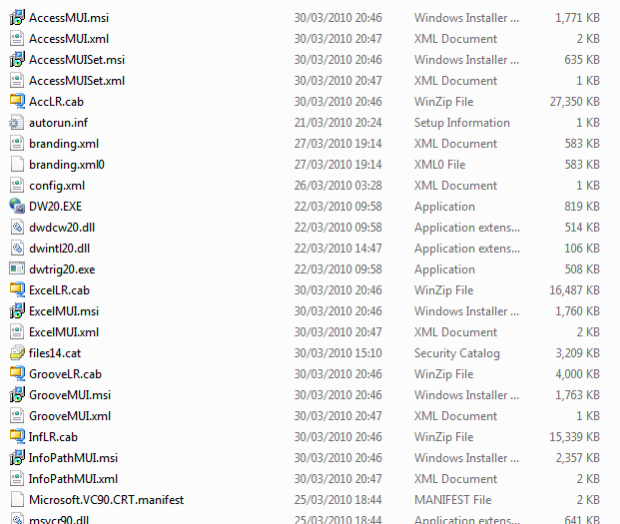To totally unlock this section you need to Log-in
Login
Consider you try to install Office 2007 or Office 2010 applications [like Office 2007/2010 Standard / Professional / Enterprise / SharePoint Designer / OneNote 2007/2010 / Windows SharePoint Services / Language Packs of WSS or of Office 2007/2010 or of MOSS 2007/2010 (i.e. SharePoint Server 2007) / Visio 2007 / Project 2007/2010 , etc.] from files that are downloaded from the web or from a CD.
You might have downloaded the product / package as a .img file [image file] or a .ISO file or it may be an executable (i.e. .exe file).
Then you may encounter the following error immediately the setup is started:
The language of this installation package is not supported by your system
This error normally occurs if one or more of the following causes are true:
What are the possible causes?
Cause 1: Are you trying to install an East Asian version of the product (like Japanese or Thai)? Then this error is quite possible if your system does not have necessary supplemental language support. This normally occurs if the OS is Windows 2003 / Windows XP.
Cause 2: If you have the source file in .ISO or .IMG format, the method of extracting the setup files from the source files may result the issue.
For example, if you download MOSS 2007 Language Packs, they are available in .IMG format. With Virtual PC 2007 or using some third party software, it is possible to view all the files inside the .IMG file.
Sometimes, the utilities that you use may not be able to extract the files correctly and that may result the failture. For example, sometimes ISOBuster may not be able to get the files correctly even though no errors are displayed by it.
Cause 3: If you have the source file in .exe format, like Microsoft Office 2010 LIPs, the method of extracting the setup files from the source files may result the issue.
For example, if you use Winzip or 7Zip to extract WSS 3.0 language pack (which is .exe file), then you may encounter this issue (the folder structure will be not correct).
The "correct" directory structure, after the extraction is the following:
The "wrong" directory structure, usually obtained by using WinZIP or 7Zip tools, is the following:
Cause 4: The CD drive in the system may be faulty.
How to resolve this error?
Let us see how to resolve / workaround the error:
For Cause 1:
- Click Start, click Run, type intl.cpl in the Open box, and then click OK.
- Click the Languages tab.
- Under Supplemental language support, click to select the following:
- Install files for East Asian languages check box
- Install files for complex script and right-to-left languages check box
- Click OK.
- When you are prompted, insert the Windows Server 2003 CD into the computer's CD drive or DVD drive. Or, specify the network location where the files are located.
- Click OK.
- When you are prompted, restart the computer.
For Cause 2:
Re-extract the setup files from the source files. Try with a different utility/tool to extract the source file.
For Cause 3:
Do not use any extracting utility like WinZIP or 7zip - As a self extracting .exe file, it is possible to run the setup directly by double clicking it.
If you want to customize some of the files that are present inside the .exe file, first try this method:
1. Click Start > Run;
2. Drag and drop the .exe file to the Run window;
3. Add these words after the path name displayed in the Run window:
For example: C:\Downloads\VisioSetup.exe /?
4. As a self extracting file, it may have the options defined and it may display a window with possible options:
/q: quiet installation mode
/extract:<drive>\folder To extract the files
Kindly refer http://support.microsoft.com/kb/912203/en-us - Description of the command-line switches that are supported by a software installation package, an update package, or a hotfix package that was created by using Microsoft Self-Extractor for more information on this.
5. If you get above said options, click OK button on the window which shows the options so that it will disapper. Then you can try these steps:
- In Start > Run, drag and drop the executable file
- At the end of it, add this parameter: /extract:<path>. Then click OK to extract the files to the <path>
For example, entering /extract:C:\Visio will put the setup files in the folder C:\Visio. Note that there is NO SPACE between /extract: and C:.
Get into the folder and run the required setup file, normally setup.exe; instead, if you want to run the installation without extracting the files and you do see /quiet option, go with that one by entering the following and clicking OK button in Start > Run:
<execuatable file name with path> /quiet
For Cause 4:
First try to copy all the files from the CD media to hard drive location and then run the setup from the hard drive location. Even if that fails, try to install the product on a different machine (using different CD drive). If that works, connect a different CD drive to the required system and start the installation.




